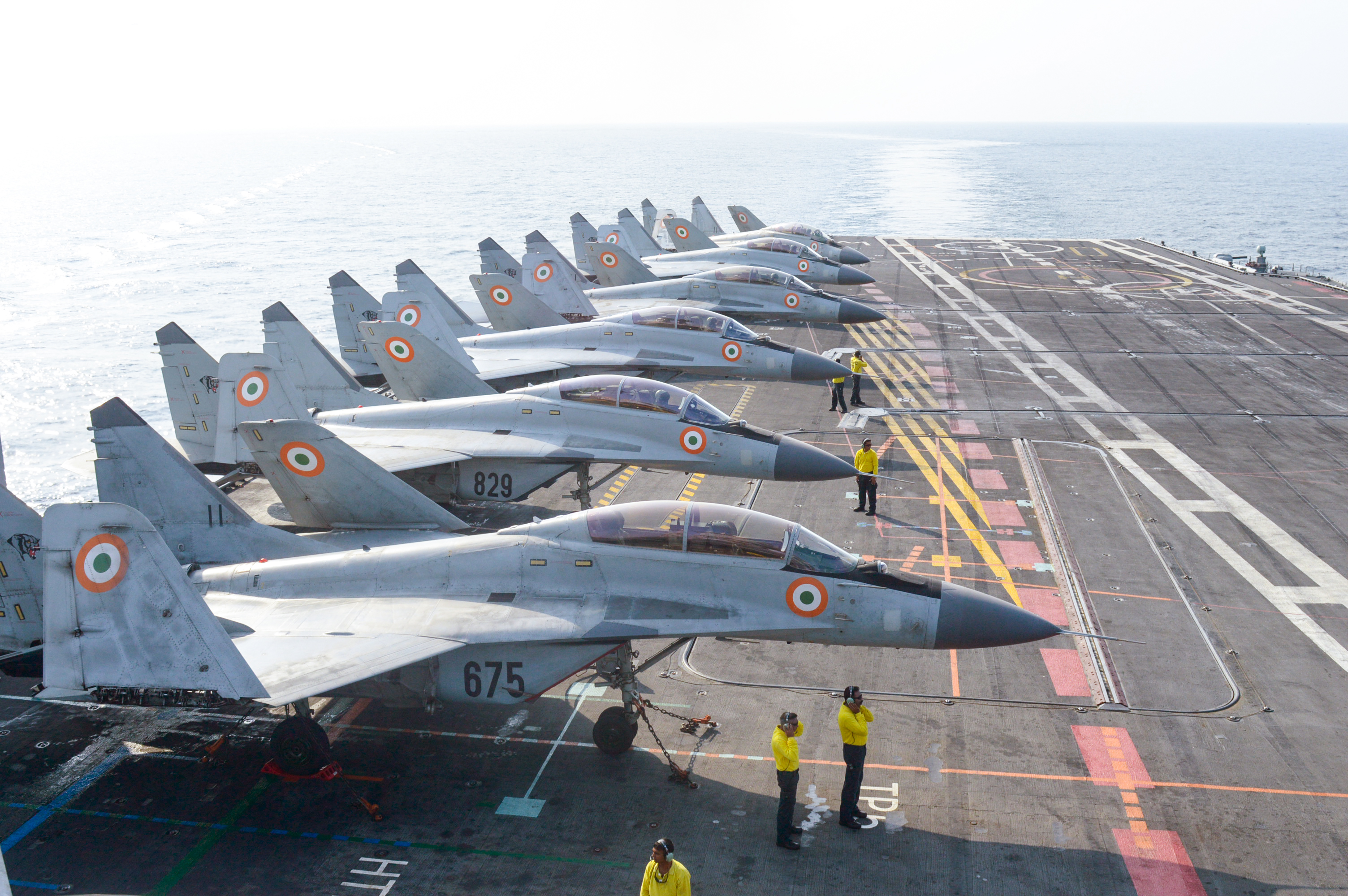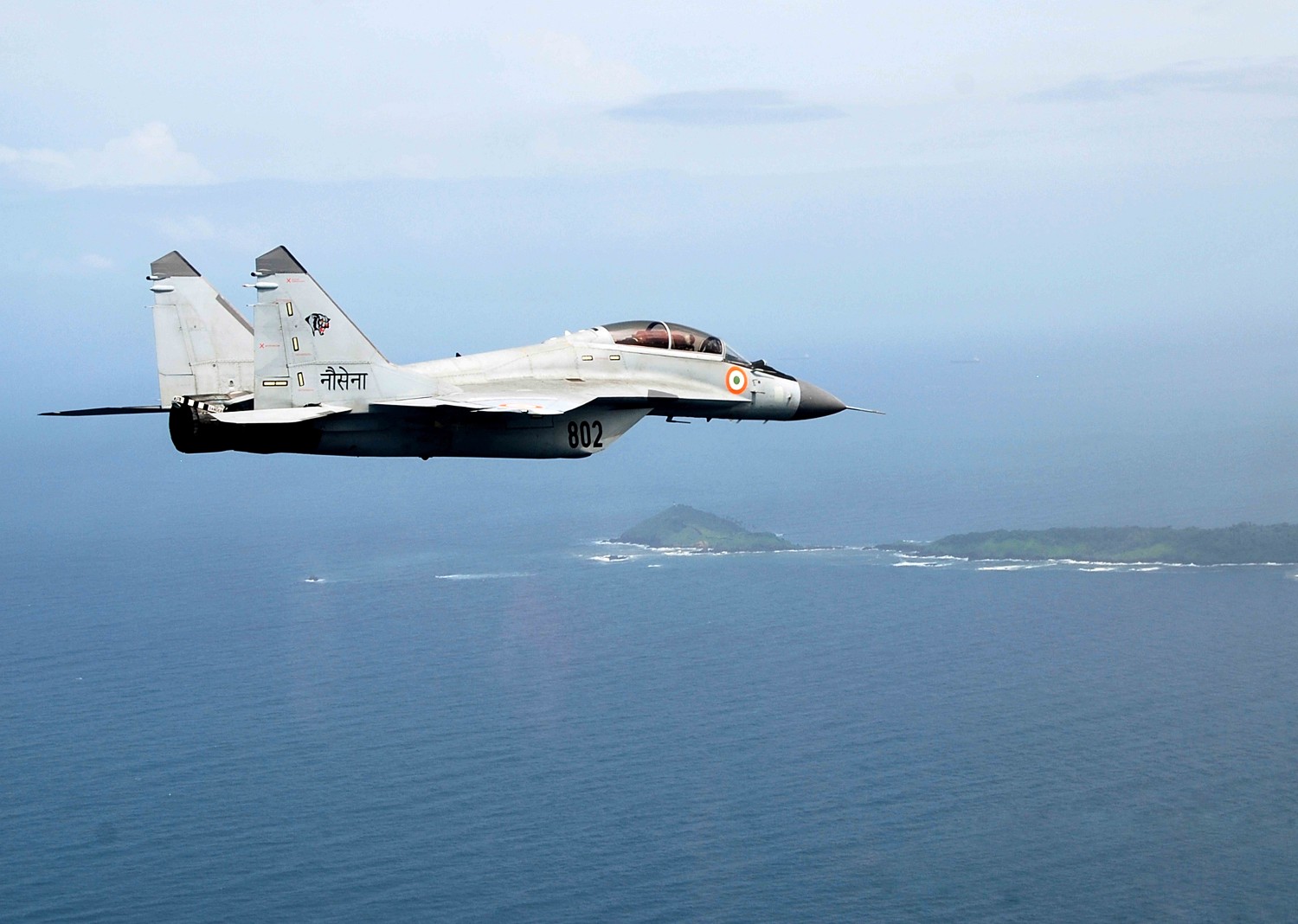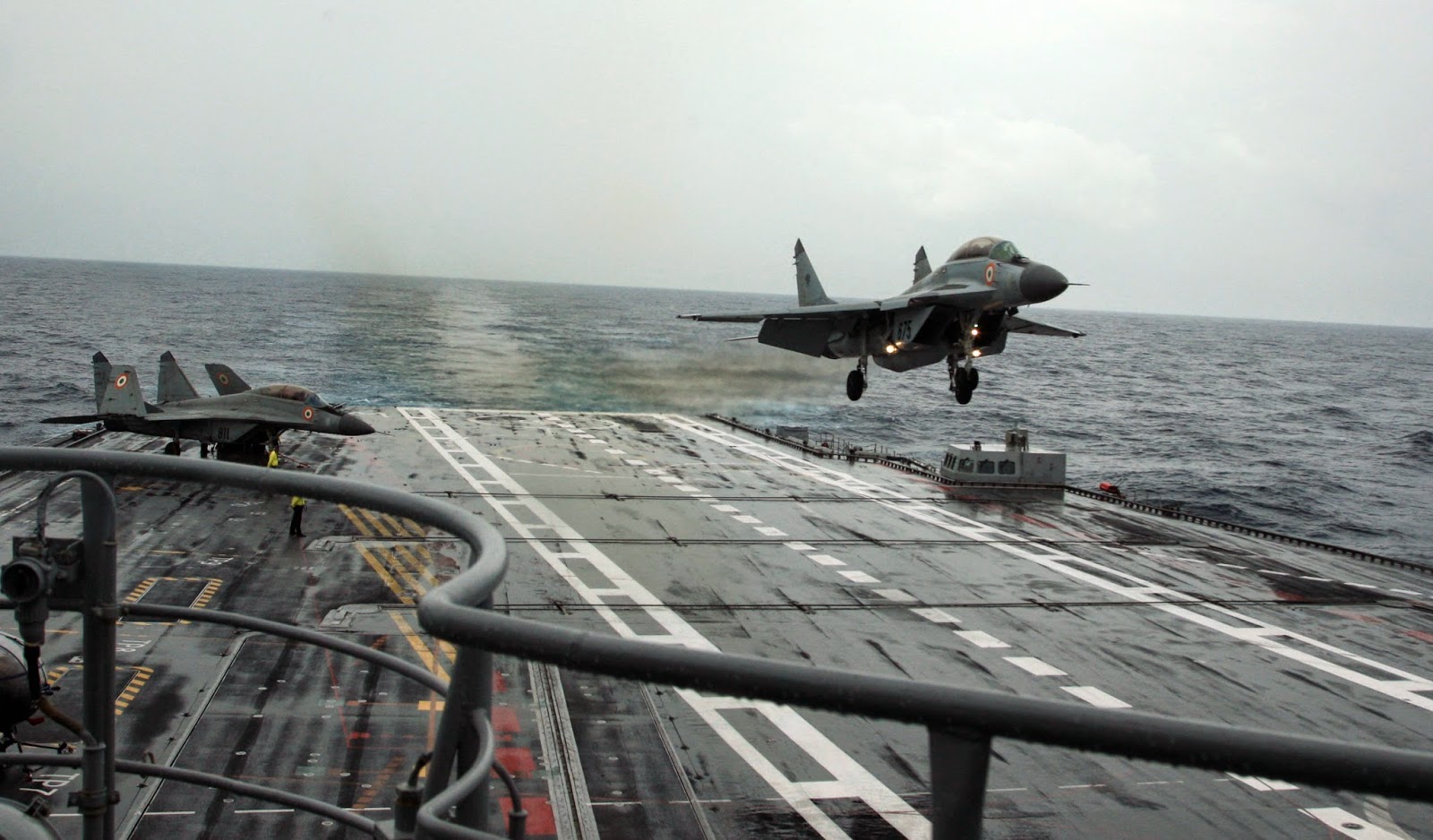- Yes, as a tech tree vehicle
- Yes, as a premium vehicle
- Yes, as an event vehicle
- Yes, as a squadron vehicle
- No, I would not like to see the MiG-29K in game.

Introduction
How much can you redesign an aircraft before it’s not the same plane anymore? The infamous “Ship of Theseus” (or Plane of Theseus in this case) dilemma has some interesting examples across aviation history. If you were to ask someone familiar with modern aircraft the question I opened with, they might point to the MiG-29K as the upper limit of what you can consider a redesign rather than an entirely new aircraft. It looks a lot like a MiG-29, it flies a lot like a MiG-29, but the aircraft has been so thoroughly redesigned that it might be hard to call it a MiG-29. Despite appearances, the MiG-29K has effectively zero parts commonality with the base MiG-29, profoundly different aerodynamic characteristics and a completely redone weapons architecture.
The result is something that has been called a “4+ generation” jet fighter - a term mainly used by Russian firms to refer to their aircraft. Where this falls into place compared to the Western “4.5th generation” is unclear, but the MiG-29K, while below that threshold, is nothing to be trifled with. As of now, the MiG-29K is fielded aboard the aircraft carrier Admiral Kuznetsov of the Russian Navy and INS Vikramaditya with the Indian Navy, additionally having done landing trials on INS Vikrant. Until HAL’s latest naval fighter project bears fruit, the MiG-29K will stay in service with the Indian Navy for the foreseeable future, and with very little effort the aircraft could be properly prepared for such a duty.
TL;DR
- Multirole 4+ generation jet fighter forming the backbone of India’s naval air arm
- Total redesign of the MiG-29 enhancing numerous capabilities
- New intakes and FOD shields minimize engine air flow loss during takeoff/low speed maneuvers
- Static instability combined with new flaps/elevators gives improved maneuverability
- RD-33MK engines provide more thrust and much less smoke than typical MiG-29 engines
- Nine total hardpoints provide more carrying capacity for all missions
- R-73 and R-77 missiles directed by Zhuk-ME radar and OLS-UEM IRST for various ranges of engagement
- TV-guided missiles/bombs provide limited CAS capability
- Larger internal fuel capacity for longer missions
- Laden weight significantly heavier than even the MiG-29SMT
- Modern digital RWR but very low chaff/flare count
- Lack of targeting pod
Why it should be in the game: The MiG-29K rectifies most of the issues with the MiG-29 but doesn’t quite stack up to 4.5th generation fighters such as the Typhoon or Rafale. It would be a natural progression for the game, then, while not being too much of a leg up over the competition. Its historical significance combined with its power would make it a good introduction for India’s aircraft and leave a nice first impression, while its Achilles’ heel (in War Thunder anyway) of a low flare count means that it’s not an all-powerful beast. Russia could get a near-identical model which means this addition would be beneficial for more than one tech tree. The latter could even expand to the whole MiG-29M lineage, which would be very nice to see.
History
Unsurprisingly, the story of the MiG-29K starts with the MiG-29. Even in the late 1970’s, the design team at Mikoyan recognized that their air superiority fighter had plenty of room for improvement. With government funding, work was able to commence on the MiG-29M (izdeliye 9-15) through the 1980’s, and it was certainly a lot of work. Deficiencies were identified in the original aircraft’s operating radius, cockpit instrumentation, low speed maneuverability and weapons load (especially in terms of precision ground strikes.) While correcting these, Mikoyan also included modern composites and radar absorbent materials, which besides saving weight significantly reduced the MiG-29M’s RCS compared to its progenitor. The composites, combined with the removal of the auxiliary intakes, allowed for over 1,000 liters of extra internal fuel capacity. Said auxiliary intakes were a novel feature but led to unacceptable performance losses at low speeds, so they were deleted and the solid doors that normally cover the intakes during takeoff were replaced with hinging grilles deeper into the intakes. Combined with hinging intake lips which gather more air during sharp maneuvers, the low speed air flow disturbance which held the RD-33s back before was no longer an obstacle. Maneuverability was also increased thanks to a statically unstable airframe and increased elevator/leading edge slat area. The MiG-29M’s track record of fixing the MiG-29’s greatest deficiencies continued with a new N010 Zhuk radar system with four datalink channels. This let the MiG-29M handle the new R-77 active radar homing missile, of which it could carry one on all eight of its total wing stations. Other new weapons included up to eight R-73s, up to six Kh-29s or Kh-31A/Ps, and up to four R-27s compared to the MiG-29’s two (albeit still limited to two R-27Es.) These changes added weight, so the uprated RD-33K engines were installed which maintained performance on par with the original MiG-29 when taking the new intake features into account. Overall, it was a massive leap forward for the venerable air superiority fighter.
This first version of the MiG-29K (izdeliye 9-31) was developed during the Cold War. Due to different construction techniques the spine is slimmer on the Soviet-era MiG-29M family, and the canopy is significantly smaller owing to the fact that all Russian-era MiG-29Ms are two-seaters, with single seat fighters simply replacing the second crew member’s seat with a fuel tank.
The reason the history of the MiG-29M is important is because the MiG-29K is an offshoot of it. In its original form (izdeliye 9-31) the MiG-29K was essentially a navalized MiG-29M, with reinforced landing gear, folding wings, corrosion-resistant material and an arrestor hook. In order to operate from Soviet carriers the MiG-29K’s engines had an enhanced boost setting which was meant to be used only briefly during takeoff. A retractable IFR probe also extended its range even further. There was a projected trainer version (izdeliye 9-37) which would be a two-seater aircraft, but the MiG-29K program would come to an abrupt halt due to the collapse of the Soviet Union. The new Russian government could not afford to purchase both Sukhoi’s and Mikoyan’s fighters and in the end decided the Flanker would be the better option for them. This dried up what funding there was for the MiG-29M program, and all of Mikoyan’s private funding for the project was devoted to the M rather than the K. After all, the MiG-29M at least had a chance for export. It’s not like anyone operated a Soviet aircraft carrier besides the Russian Navy.
INS Vikramaditya (R33) at sea. Compared to Admiral Kuznetsov, Vikramaditya received a ramp on the bow at the cost of some simultaneous launching capability and weapons carriage. A Sea Harrier FRS.51 of the Indian Navy can be seen flying alongside the carrier. The refit program was a success but took a lot of time and money. India would later construct their first indigenous carrier, INS Vikrant (R11).
That would not be the case for long, though. The Soviet-era carrier Admiral Gorshkov was deactivated by the Russian government in 1996. India already had a business relationship with the former Soviet Union and wanted a more capable carrier than the two light carriers they already operated. While Admiral Gorshkov was hardly a supercarrier, she would be able to handle more than the Sea Harriers the Indian Naval Air Arm operated at the time. Eventually a deal was struck with the Russians to purchase and refurbish the aircraft carrier. The modification program was somewhat extensive and dragged on for a while but eventually INS Vikramaditya took to the seas. Besides the carrier itself, the Indian Navy was faced with the question of what aircraft to operate from the decks of their new ship. The choice came down to two Russian aircraft - Sukhoi submitted their Su-33 carrier-based fighter version of the Su-27 and Mikoyan submitted the MiG-29K. The Indian Navy chose the MiG-29K because they were smaller than the Su-33s, allowing for more to be stowed on the relatively limited deck space of Vikramaditya. However, the MiG-29K submitted was the same Soviet-era izdeliye 9-31, which was deemed unacceptable and required upgrading.
Quite a good shot of a touch-and-go landing on the deck of Vikramaditya being performed by an Indian Navy MiG-29K. There is one visible on deck in the background which shows the folding wings that help lower the fighter’s footprint when not in use. The sheer size of the canopy is also evident, and this gives the pilot a very wide field of view.
The new MiG-29K (izdeliye 9-41), while based on the old 9-31, received several upgrades that set it apart. For one, the RD-33MK engines were used. These engines squeeze 9,000 kgf of static thrust out of the RD-33 platform with modern materials and use a new combustion chamber to reduce smoke signature. The radar was now the N010M Zhuk-ME which besides having better range was given new targeting modes which are especially useful for anti-ship operations. An improved OLS-UEM IRST unit was installed and together with the radar and Thales TopSight HMS formed the fire control system of the new MiG-29K. Internal and suspended fuel capacity was increased even compared to the MiG-29M with the ability to carry four drop tanks underwing and an enlarged centerline tank. An unfortunate casualty of the redone fuel tanks was the (planned) internal countermeasures dispensers of the MiG-29M. While the Soviet-era version would have double the countermeasure count of the standard MiG-29, the MiG-29K (9-41) was limited to 32 total charges - 16 were found on the outside of each engine nacelle in twin packs of eight. Even considering the fact that they are large calibre flares, it’s a shame for War Thunder but understandable since the MiG-29K was primarily devoted to long-range combat, in which it was aided by a similar IFR probe to the 9-31. That’s not to say it was a slouch in a dogfight, since it inherited the MiG-29M’s instability with a new FBW system which accounted for the aerodynamic differences of the redone fighter. An almost entirely digital cockpit aided pilots in information processing and made for a less cluttered instrument display. The MiG-29K featured plenty of Indian and foreign avionics alike with a few examples including the Tarang digital RWR, ELTA EL/L-8222 suspended ECM pod and French Sagem Sigma-95 SATNAV. A high speed open architecture databus connecting all these systems allowed for potential future upgrades too.
One MiG-29K, 827, was shown with a variety of new weapons and systems in February 2025. This includes ECM pods, the indigenous Astra BVRAAM, LITENING targeting pod, laser guided bombs and indigenous NASM-MR anti-ship missiles. Over the coming years it is likely that the MiG-29K will integrate these systems in order to enhance its multirole capability.
The MiG-29K entered service with the Indian Navy in 2010 with an initial order of twelve single seat aircraft and four MiG-29KUB trainer planes. Over time this would expand to 37 fighters and 8 trainers total. Its service was off to a rocky start especially because INS Vikramaditya wasn’t ready at the time of the plane’s induction. Even after this there were chronic serviceability issues due to defects in the engines, airframe and FBW system. It was only by the end of 2018 that serviceability was raised to a more acceptable 70%. The MiG-29K continues to be the backbone fleet defense fighter of India’s Naval Air Arm into the present day. They follow Vikramaditya wherever she goes, recently participating in naval exercises and other standard duties of the Naval Air Arm. INS Vikrant, India’s first indigenous aircraft carrier, is also planned to field more MiG-29Ks in the near future after having completed integration trials in 2023. It was revealed in February 2025 that in order to enhance the aircraft’s capabilities further an indigenous Mission Computer module has been integrated with the entire fleet. This system will allow the MiG-29K’s existing electronics to interface with whatever weapons the Indian Navy wishes to integrate. Likely candidates include the indigenous Astra Mk.II active radar homing air-to-air missile and LITENING targeting pod, enhancing its air combat lethality and precision strike capability in one fell swoop. In order to integrate Astra the Navy needs to perform rigorous tests with the missile and it will likely not be fully integrated for another few years. As of now the MiG-29K has not been deployed in any active conflict or as a deterrent, but its capabilities give India some real presence in the region. The forward-thinking navy is envisioning an indigenous replacement for the MiG-29K but since HAL’s TEDBF project is still in the conceptual stage and a naval variant of the Tejas was deemed too heavy the MiG will have to serve as a stopgap. The latest upgrades help it perform this job more effectively.
Specifications
Mikoyan MiG-29K (9-41)
Dimensions:
- Length: 17.3 m (56 ft 9 in)
- Span: 11.99 m (39 ft 4 in)
- Height: 4.4 m (14 ft 5 in)
Weight:
- 18,550 kg (40,896 lb) takeoff
- 24,500 kg (54,013 lb) MTOW
Propulsion: 2 x Klimov RD-33MK low-bypass turbofan engine
- 5,400 kgf (11,905 lbf) dry static thrust each; 10,800 kgf (23,810 lbf) thrust total
- 9,000 kgf (19,842 lbf) wet static thrust each; 18,000 kgf (39,683 lbf) thrust total
Maximum speed:
- 1,400 km/h (870 mph) at sea level
- 2,200 km/h (1,367 mph) at high altitude
Service ceiling: 17,500 m (57,415 ft)
Armament:
- Guns:
- 1 x GSh-30-1 30 mm autocannon (150 rounds)
- Air-to-air missiles:
- Up to 8 x R-73 IR-homing air-to-air missile
- Up to 6 x RVV-AE active radar homing air-to-air missile
- Bombs:
- Up to 11 x FAB-500M62 500 kg low-drag general purpose bomb
- Unspecified amount of smaller bombs can be carried
- Guided bombs:
- Up to 4 x KAB-500Kr 500 kg TV-guided bomb
- Rockets:
- Up to 120 x S-8KOM 80 mm rocket
- Up to 6 x S-24 240 mm rocket
- Air-to-ground missiles:
- Up to 2 x Rampage GPS-guided missile
- Anti-ship missiles:
- Up to 4 x Kh-31A anti-ship missile
- Up to 4 x Kh-35E anti-ship missile
- Anti-radiation homing missiles:
- Up to 4 x Kh-31P anti-radiation homing missile
- Drop tanks:
- Up to 1 x 2,000 liter (528 U.S. gallon) drop tank
- Up to 4 x 1,100 liter (291 U.S. gallon) drop tank
Crew: 1
Additional equipment:
- N010M Zhuk-ME radar
- OLS-UEM IRST unit
- Ballistic computer: CCIP/RP (Guns, rockets and bombs)
- Tarang RWR
- ELTA EL/L-8222 suspended ECM pod
- Countermeasures dispensers:
- 2 x 16 round 50 mm (large calibre) countermeasures dispenser, one outboard of each engine nacelle (32 charges total)
- Digital MFDs
- HMS/HMD
- Ejection seat
- Arrestor hook
- IFR probe
Gallery








Sources
- Famous Russian Aircraft: Mikoyan MiG-29 by Yefim Gordon (2006)
- Take-off Magazine (February 2011 Aero India special issue)
- MoD signs over Rs 2,900 crore contract with BDL for procurement of ASTRA Mk I Beyond Visual Range Air to Air Missile System & Associated Equipment for Indian Air Force & Indian Navy
- Indian Air Force approves the production of 200 Astra Mark 1 to replace Russian air-to-air missiles
- INS Vikramaditya - Wikipedia
- https://www.defense-aerospace.com/india-auditor-tells-dismal-story-of-navys-mig-29k-fighters/
- All Issues Pertaining to Serviceability of MiG-29K Sorted Out - Indian Navy | Indian Defence News
- key.Aero, Military Aviation
- Why India Doesn’t Like Its Russian-Made Missiles - The National Interest
- TRISHUL: IAF's MiG-29UPG Upgrade Package Detailed
- - MiG-29K/KUB
- Shipborne aircraft / Shipborne training-combat aircraft MiG-29K/KUB | Catalog Rosoboronexport
- Indian Navy’s MiG-29K Fleet Upgraded with Indigenous Mission Computer, Set for Astra MKI Integration – Indian Defence Research Wing















